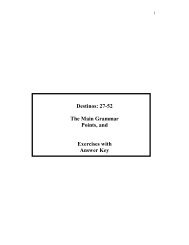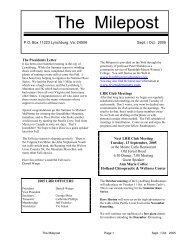Math 360 ALGEBRA HOMEWORK 9 SOLUTIONS Proofs the ...
Math 360 ALGEBRA HOMEWORK 9 SOLUTIONS Proofs the ...
Math 360 ALGEBRA HOMEWORK 9 SOLUTIONS Proofs the ...
Create successful ePaper yourself
Turn your PDF publications into a flip-book with our unique Google optimized e-Paper software.
<strong>Math</strong> <strong>360</strong> <strong>ALGEBRA</strong> <strong>HOMEWORK</strong> 9 <strong>SOLUTIONS</strong><br />
<strong>Proofs</strong> <strong>the</strong> properties of a homomorphism: These are in <strong>the</strong> book.<br />
Chapter 10 #6. Let P be <strong>the</strong> set of polynomials with real coefficients. P is a group under<br />
addition. Define φ : P → P by<br />
φ(a n x n + a n−1 x n−1 + . . . + a 1 x + a 0 ) =<br />
a n<br />
n + 1 xn+1 + a n−1<br />
n xn + . . . + a 1<br />
2 x + a 0x + 0.<br />
Note that <strong>the</strong> constant term is zero because <strong>the</strong> problem requires <strong>the</strong> antiderivative to pass through<br />
(0,0).<br />
Let f, g be two polynomials in P . Then it is easy to see that φ(f + g) = φ(f) + φ(g) hence that<br />
φ is a homomorphism.<br />
Ker(φ) = {f ∈ P |φ(f) = 0} = 0 (Only <strong>the</strong> zero function maps to zero).<br />
If <strong>the</strong> mapping was defined so that <strong>the</strong> antiderivative passed through (0,1) instead of (0,0) <strong>the</strong>n<br />
it would not be a homomorphism. Because <strong>the</strong>n<br />
φ(a n x n + a n−1 x n−1 + . . . + a 1 x + a 0 ) =<br />
For x and 1 in P we have<br />
a n<br />
n + 1 xn+1 + a n−1<br />
n xn + . . . + a 1<br />
2 x + a 0x + 1.<br />
φ(x + 1) = x2<br />
2<br />
+ x + 1 whereas φ(x) + φ(1) =<br />
x2<br />
2 + 1 + x + 1.<br />
Chapter 10 #8. For sgn(αβ) <strong>the</strong>re are four cases to consider:<br />
case 1: α even β even.<br />
case 2: α even β odd<br />
case 3: α odd β even<br />
case 4: α odd β odd<br />
Check that in ei<strong>the</strong>r case <strong>the</strong> operation is preserved.<br />
Ker(sgn) = {σ ∈ S n |sgn(σ) = 1} = A n .<br />
Chapter 10 #17. Suppose <strong>the</strong>re is a homomorphism φ from Z 16 ⊗ Z 2 onto Z 4 ⊗ Z 4 . Then by<br />
<strong>the</strong> first isomorphism <strong>the</strong>orem<br />
Z 16 ⊗ Z 2 /Kerφ ∼ = Z 4 ⊗ Z 4 .<br />
Comparing <strong>the</strong> number of elements we get that |Kerφ| = 2. Since Z 16 ⊗ Z 2 is Abelian, all<br />
subgroups are normal. So possibilities for Kerφ are subgroups of order 2 in Z 16 ⊗ Z 2 . There are<br />
three such subgroups:<br />
1
H 1 = {(0, 0), (8, 1)}, H 2 = {(0, 0), (0, 1)}, and H 3 = {(0, 0), (8, 0)}.<br />
If Kerφ = H 1 <strong>the</strong>n (1, 0) + Kerφ has order 16 but Z 4 ⊗ Z 4 has no element of order 16.<br />
If Kerφ = H 2 <strong>the</strong>n (1, 0) + Kerφ has order 16 but Z 4 ⊗ Z 4 has no element of order 16.<br />
If Kerφ = H 3 <strong>the</strong>n (1, 0) + Kerφ has order 8 but Z 4 ⊗ Z 4 has no element of order 8.<br />
Therefore <strong>the</strong>re are no homomorphisms from Z 16 ⊗ Z 2 onto Z 4 ⊗ Z 4 .<br />
Chapter 10 #20. There are no homomorphisms from Z 20 onto Z 8 because if <strong>the</strong>re were such<br />
a homomorphism, say φ, <strong>the</strong>n by <strong>the</strong> first isomorphism <strong>the</strong>orem Z 20 /Kerφ ∼ = Z 8 . This would imply<br />
20 = |Kerφ| × 8(why?) which is not possible.<br />
There are homomorphisms from Z 20 toZ 8 that are not onto.<br />
Let φ be one such map. Then Z 20 /Kerφ ∼ = Imφ. Since Z 20 is finite, we have |Kerφ||Imφ| = 20<br />
Kerφ is a subgroup of Z 20 and Imφ is a subgroup of Z 8 so possibilities are<br />
1. |Kerφ| = 5 and |Imφ| = 4<br />
2. |Kerφ| = 10 and |Imφ| = 2<br />
Recall that Z 20 has only one subgroup of order 5, and only one subgroup of order 10.<br />
Because Z 20 is cyclic φ is determined by its action on its generator 1.<br />
For case 1, i.e. when |Kerφ| = 5, we have Kerφ = {0, 4, 8, 12, 16}.<br />
Let φ(1) = 2 (it should map to something of order 4 in Z 8 , why?).<br />
All <strong>the</strong> elements in a coset should map to <strong>the</strong> same element (why?), so<br />
elements in 0 + Kerφ = {0, 4, 8, 12, 16} map to 0.<br />
elements in 1 + Kerφ = {1, 5, 9, 13, 17} map to 2.<br />
elements in 2 + Kerφ = {2, 6, 10, 14, 18} map to 4. (why?)<br />
elements in 3 + Kerφ = {3, 7, 11, 15, 19} map to 6. (why?)<br />
Carry out a similar argument for <strong>the</strong> second case, that is when |Kerφ| = 10.<br />
Chapter 10 #33. φ : U 40 → U 40 is a homomorphism with kernel {1, 9, 17, 33}. Suppose<br />
φ(11) = 11<br />
Note that for a homomorphism φ, φ(a) = φ(b), iff φ(ab −1 ) = 1 iff ab −1 ∈ Kerφ, that is<br />
a ∈ bKerφ. Therefore if φ(11) = 11 <strong>the</strong>n <strong>the</strong> elements that map to 11 are precisely <strong>the</strong> elements in<br />
11Kerφ = {11, 19, 27, 3}.<br />
Chapter 10 #34. Find a homomorphism as in problem 33.<br />
We need to determine where each of <strong>the</strong> cosets of Kerφ map. We already have<br />
elements in 11Kerφ = {1, 9, 17, 33} map to 1.<br />
elements in 11Kerφ = {11, 19, 27, 3} map to 11.<br />
2
If we map <strong>the</strong> o<strong>the</strong>r two cosets as follows we get a homomorphism as desired:<br />
Elements in 7Kerφ = {7, 23, 39, 31} map to 7.<br />
Elements in 13Kerφ = {13, 37, 21, 29} map to 13.<br />
Think: Can you find o<strong>the</strong>rs?<br />
Chapter 10 #36. Let φ : Z ⊗ Z → G be such that φ((3, 2)) = a and φ((2, 1)) = b.<br />
Then φ((3, 2) − (2, 1)) = φ((3, 2)) − φ((2, 1)) = a − b and φ((4, 4)) = φ(4(1, 1)) = 4φ((1, 1) =<br />
4(a − b) using <strong>the</strong> fact that φ is a homomorphism.<br />
Chapter 10 #39. Second Isomorphism Theorem: If K is a subgroup of G and N is a normal<br />
subgroup of G, <strong>the</strong>n K/(K ∩ N) ∼ = KN/N.<br />
1. Prove that K ∩ N is normal in K.<br />
2. Prove that N is normal in KN.<br />
3. Prove that <strong>the</strong> map φ : K → KN/N given by φ(k) = kN is a homomorphism and is onto.<br />
4. Apply <strong>the</strong> first isomorphism <strong>the</strong>orem.<br />
<strong>Proofs</strong>:<br />
1. Let a ∈ K ∩ N and b ∈ K. We need to prove that x = bab −1 ∈ K ∩ N. Since N is normal in<br />
G and b ∈ G and a ∈ N we have x ∈ N.<br />
x is also in K because a and b are both in K and K is a subgroup.<br />
2.Let a ∈ N and b ∈ KN. We need to prove that x = bab −1 ∈ N. Since N is normal in G and<br />
b ∈ KN ⊂ G and a ∈ N we have x ∈ N.<br />
3.Let k 1 , k 2 ∈ K. Then φ(k 1 k 2 ) = (k 1 k 2 )N = k 1 Nk 2 N = phi(k 1 )φ(k 2 ). The second equality<br />
holds by definition of product of cosets. Therefore φ is a homomorphism.<br />
φ is onto because a coset in KN/N is of <strong>the</strong> form knN for some k ∈ K and n ∈ N. Note that<br />
nN = N because n ∈ N. Then φ(K) = kN so any coset coset in KN/N is hit by φ.<br />
4. Kerφ = {k ∈ K|φ(k) = N} so Kerφ = {k ∈ K|kN = N} = {k ∈ K|k ∈ N} = K ∩ N.<br />
Hence by <strong>the</strong> first isomorphism <strong>the</strong>orem K/(K ∩ N) ∼ = KN/N<br />
Chapter 10 #50. Let G = 〈a〉. Any element in G is of <strong>the</strong> form a k for some k ∈ Z and for a<br />
homomorphism φ, φ(a k ) = (φ(a)) k . So if φ(a) is given, <strong>the</strong> images of <strong>the</strong> rest of <strong>the</strong> elements will<br />
be determined by it.<br />
3


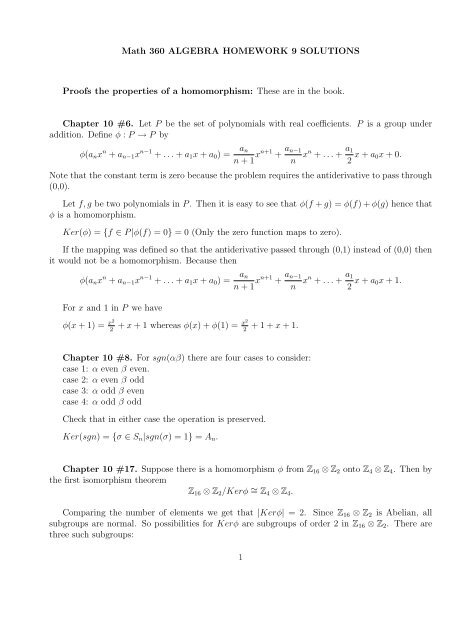


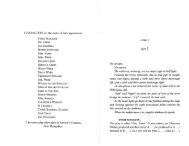



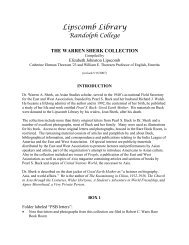
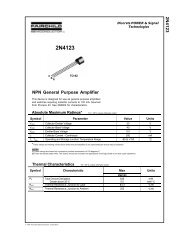

![Cast & Crew List [Program Copy pdf] - Randolph College](https://img.yumpu.com/38268916/1/190x123/cast-crew-list-program-copy-pdf-randolph-college.jpg?quality=85)


